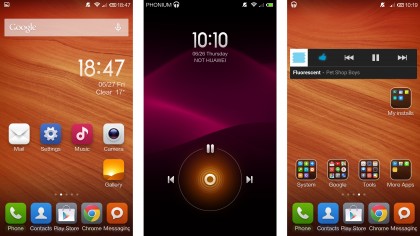Why you can trust TechRadar
The Xiaomi Mi 3 runs Android, although in places its MIUI interface is barely recognisable as using Google's code and owes quite a debt to some iOS features, too.
Much like the Android skin adopted by Chinese rival Huawei, MIUI dumps the key Android idea of the app drawer. Instead there is an icon for every app installed on the phone upon one of its infinitely customisable home screens.
This seems like a workable idea once you've got used to it, although, as with iOS devices, it invariably means you end up with a few folders in which you dump things you know you won't ever use.
One reason to shuffle your icons around is Xiaomi's haptic feedback. The Mi 3 creates the most satisfying sci-fi "badabum" vibration effect when plonking icons on the home screens.

The icons look lovely too. MIUI's key strength is in the design of its home and lock screens, with the icon sets doing a great job of adding uniformity, colour and style to the Android core.
The clocks are great, the many choices of screen transition effect add variety, plus the years of development that's gone into MIUI means the software is ludicrously customisable.
The OS features almost as many toggles and options to play with as the hardcore CyanogenMod code that's available as an aftermarket DIY install option for many phones, or preloaded in the Oppo N1 and OnePlus One.
Sign up for breaking news, reviews, opinion, top tech deals, and more.
Creating folders is as simple as dragging one icon atop another. If you're new to Android, Xiaomi pre-loads a "read me" app on the home screen, which provides a checklist of common Android and MIUI features to help newcomers to smartphones acclimatise themselves.
On the Mi 3's MIUI you can customise the name of the network in the top-left of the status bar (or hide it altogether if it offends you), plus there are options to define the actions of the capacitive buttons.
By default, the backlight of the buttons turns off after a few seconds, meaning you have to guess where back or menu is, so it's really nice to have a permanently on option.

One quirk of MIUI is that Google Now isn't accessible from the lock screen. Instead there is a shortcut that turns on the camera flash's torch option behind the home key long-press where Google Now usually sits. An odd choice but one that might suit people who prefer illumination to knowing about local cinema listings.
Despite this being a Chinese model, the fact that the MIUI Android ROM has been in development around the world for years means you get a full English experience. Select English as the system language from first boot and it's perfect, with the Xiaomi phone, managing a better tone and translation than the officially-available-here English Huawei models.
From that point on you can forget it's a China-only mobile, and enjoy direct updates of the MIUI software when they become available.
Current page: Key features and interface
Prev Page Introduction Next Page Performance and battery life